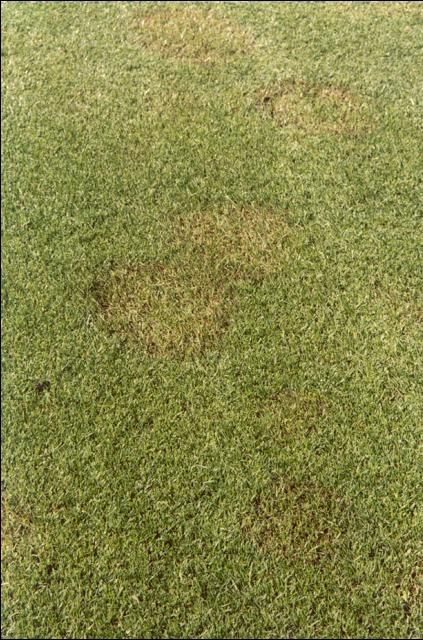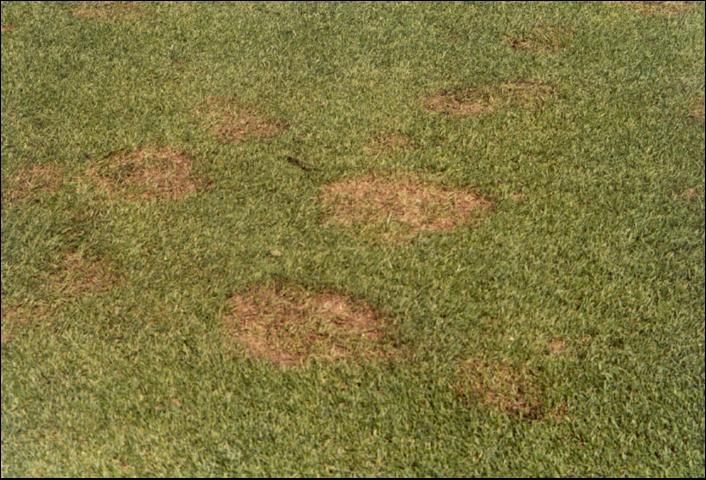Pythium Blight on Overseeded Turfgrass
Pythium blight, also called cottony blight, is a fungal lawn disease that rapidly kills cool-season turfgrasses overseeded as winter cover of warm-season species. The disease can occur on bermudagrass in the summer, but disease severity on this warm-season species is often limited when compared to the damage caused to cool-season turfgrass. Pythium aphanidermatum as well as other species, such as P. torulosum, have been associated with Pythium blight of overseeded turfgrasses in Florida.
Disease Symptoms and Occurrence
Weather significantly influences disease outbreaks and severity. Wet periods and high temperatures favor colonization of turf by Pythium. Temperatures around 90°F are ideal for disease development. The pathogen causes little damage below 68°F. In addition to high temperatures, extended periods of wet, foggy, or rainy conditions with high humidity are required for disease development. Frequent irrigation needed to establish an overseed can favor disease development during periods of high temperatures. Symptoms are often first observed in low areas where surface water runs, pools, and drains. Severe disease outbreaks commonly occur on turfgrass sites that are over-irrigated or poorly drained.

Credit: Gail Wisler and Carol Stiles
Pythium blight can quickly spread to kill large areas of turfgrass. When conditions have been favorable for disease spread, distinct and well-defined areas of turfgrass may first appear watersoaked, dark, and wilted (Figure 1). As disease progresses, the turf will collapse and appear brown and matted, sometimes with a bronze or red tinge to the border of the affected area (Figure 2). Extended periods of high humidity or leaf wetness may result in a white cottony growth of aerial mycelium on symptomatic turf (Figure 3). Initial symptoms can appear to have spread along paths of mechanical movement of diseased tissue, such as mowing patterns, and along paths of surface water drainage. The pathogen can kill seedlings as well as an established turfgrass. Turfgrass is killed in a radial pattern outward from the initial disease outbreak as long as conditions are favorable for disease spread and no fungicide is applied.

Credit: Gail Wisler and Carol Stiles
Submission of a sample to a diagnostic center to confirm Pythium blight is recommended if the turf manager or homeowner is not familiar with this disease. Accurate diagnosis can help reduce the amount of fungicide used and prevent the use of fungicides that are not effective against the particular disease. Disease diagnosis is available for a minimal fee from the UF/IFAS Plant Diagnostic Center (https://edis.ifas.ufl.edu/sr007).

Credit: Lawrence Datnoff
Disease Management
All cool-season species commonly used to overseed turfgrass in Florida are susceptible to Pythium blight. Though bermudagrass cultivars likely differ in susceptibility, no significant differences have been identified. Horticultural practices can influence Pythium blight. However, not even ideal practices will prevent disease occurrence in all cases if environmental conditions become highly favorable.
Irrigation practices should be employed that do not extend periods of leaf wetness and that do not waterlog soils, especially in low areas. Improving air circulation around problematic turfgrass areas can also be beneficial. Trimming surrounding foliage or using fans on golf course greens may help hasten drying of the area and lessen the likelihood of disease outbreak. Excessive applications of available nitrogen should be avoided during and directly prior to disease-favorable conditions. This is recommended because new lush turfgrass growth seems to be more susceptible to disease damage. The disease can be spread by mechanical transmission of the pathogen. Traffic across affected areas, including mowing, should be minimized during periods of pathogen activity to reduce disease spread.
Prompt and accurate diagnosis of Pythium blight is of utmost importance if fungicide applications are to effectively control disease spread. Products that control Pythium diseases (Table 1) may not be effective against other common diseases and vice versa. Applications of the most effective fungicide products can protect healthy turf, thereby slowing or stopping disease spread from an affected area. Once symptoms are visible, recovery of affected turfgrass is not possible, and the area may have to be re-seeded.
Pythium outbreaks are likely and preventative fungicide applications are warranted when temperatures hover above 80°F during extended moist periods (e.g., frequent irrigation associated with overseed establishment). When applied prior to seeding, fungicides provide relatively poor control. However, an application at the time of seeding, seedling emergence, and one additional application 14 days later generally provide acceptable disease control when establishing an overseed. After establishment, preventative applications are often applied only to problematic areas but sometimes to entire high-value turfgrass plantings (e.g., athletic fields and golf course greens, tees, and fairways). Continued applications according to label directions may be needed as long as disease-favorable conditions persist. Populations of Pythium resistant to some of the fungicides listed in Table 1 have been reported in some areas. Products with different active ingredients should be rotated in a spray schedule to lessen the likelihood of fungicide-resistant populations developing. Product labels should be consulted for spray intervals and resistance management information.
Homeowner Control Options
Good horticultural practices outlined above can reduce the likelihood of Pythium blight on overseeded home lawns. If the disease becomes a persistent problem that requires further attention, it is recommended that the homeowner seek the services of a professional lawn care company. Professional lawn care companies will have 1) the necessary applicator licenses that some fungicides listed in Table 1 require and 2) the knowledge of which fungicides are not labeled for use in residential lawns. Some homeowners may have the equipment and knowledge required to correctly make a fungicide application, including all safety equipment. If such homeowners understand the risks to both themselves and the environment, fungicide products are available through garden centers and internet catalogs. Some of the fungicides listed in Table 1 are marketed to homeowners. For example, Monterey Aliette contains the fungicide aluminum tris and is available through Monterey Lawn and Garden Products (https://www.montereylawngarden.com). Consult your local county Extension agent (https://ifas.ufl.edu/florida-map/) or university specialist for up-to-date product recommendations because the homeowner pesticide market and product availability can change. The "Homeowner's Guide to Fungicides for Lawn and Landscape Disease Management" (https://edis.ifas.ufl.edu/pp154) can be referenced for more information on fungicide use in residential lawns.
Any person who applies pesticides should always read, understand, and follow all label instructions prior to use. Specific products are listed for example only. Neither inclusion of products nor omission of similar alternative products in this publication is meant to imply any endorsement or criticism.
Related Resources
- University of Florida Extension Plant Diagnostic Center. https://plantpath.ifas.ufl.edu/extension/plant-diagnostic-center/
- University of Florida Pest Control Guide for Turfgrass Managers, updated every two years. https://turf.ifas.ufl.edu/
- Turfgrass Disease Management. https://edis.ifas.ufl.edu/LH040
- Ask IFAS (EDIS) https://edis.ifas.ufl.edu/


